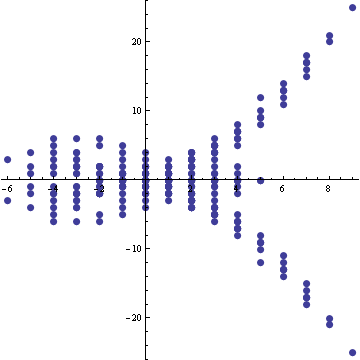Finite Type (Vassiliev) Invariants
(For In[1] see Setup)
| ||||
Thus, for example, let us reproduce Willerton's "fish" (arXiv:math.GT/0104061), the result of plotting the values of against the values of , where is the (standardly normalized) type 2 invariant of , is the (standardly normalized) type 3 invariant of , and where runs over a set of knots with equal crossing numbers (10, in the example below):
As another example, let us consider the expansion of the Jones polynomial for a knot as a power series in when we substitute the standard variable with and use the power series expansion of :
Then, for the above coefficients we have that and for all is a Vassiliev invariant of type [BirmanLin]. We can see this result by using the invariant formula:
to check the Birman-Lin condition, which tells us that an invariant is of type if it vanishes on knots with more than double points, or self intersections (see [Bar-Natan]). Computing on knots with more than one double point by resolving one self intersection at a time, it is enough to check that vanishes on knots with double points:
The following two programs let us determine for any integer and knot :
In[4]:=
|
SetCrossing[K_, l_Integer, s_] := Module[
{pd, n},
pd = PD[K];
If[PositiveQ[pd[[l]]],
If[s == "-", pd[[l]] = RotateRight@pd[[l]]],
If[s == "+", pd[[l]] = RotateLeft@pd[[l]]]];
pd];
|
In[5]:=
|
V[K_, n_] := Series[Jones[K][Exp[x]], {x, 0, n}];
V[K_, n_, {i1_, is___}] :=
V[SetCrossing[K, i1, "+"], n, {is}] -
V[SetCrossing[K, i1, "-"], n, {is}];
V[K_, n_, {}] := V[K, n];
|
The first program, SetCrossing, sets the crossing of a knot to be positive or negative depending on whether we choose to be "" or "". The second program uses the invariant formula to give the series expansion of the Jones polynomial of a knot discussed above, up to order , where a selected list of the crossings of are taken as double points. is then the coefficient of the term containing .
For example, we can check that disappears on the knot 9_47 with its first five crossings taken as double points:
In[6]:=
|
V[Knot[9, 47], 4, {1, 2, 3, 4, 5}]
|
Out[6]=
|
V[Knot[9, 47], 4, {1, 2, 3, 4, 5}]
|

[Bar-Natan] ^ D. Bar-Natan, On the Vassiliev Knot Invariants, Topology 34 (1995) 423-472.
[BirmanLin] ^ J.S. Birman and X.-S. Lin, Knot Polynomials and Vassiliev's Invariants, Invent. Math. 111 (1993) 225-270.






















